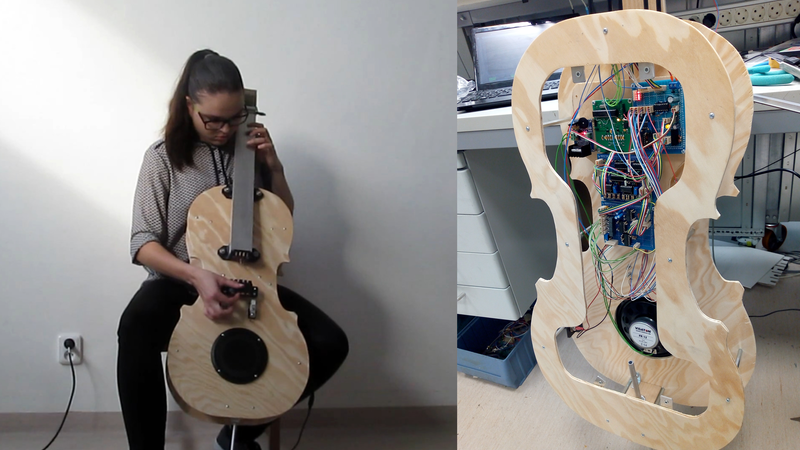For one reason or another, electronic synthesizing musical instruments are mostly based around the keyboard. Sure, you’ve got the theremin and other oddities, but VCAs and VCFs are mostly the domain of keyboard-style instruments, and have been for decades. That’s a shame, because the user interface of an instrument has a great deal to do with the repertoire of that instrument. Case in point: [jaromir]’s entry for the Hackaday Prize. It’s an electronic analog synth, in cello form. There’s no reason something like this couldn’t have been built in the 60s, and we’re shocked it wasn’t.
Instead of an electrified cello with a piezo on the bridge or some sort of magnetic pickup, this cello is a purely electronic instrument. The fingerboard is metal, and the strings are made of kanthal wire, the same wire that goes into wire-wound resistors. As a note is fingered, the length of the string is ‘measured’ as a value of resistance and used to control an oscillator. Yes, it’s weird, but we’re wondering why we haven’t seen anything like this before.
How does this cello sound? Remarkably like a cello. [jaromir] admits there are a few problems with the build — the fingerboard is too wide, and the fingerboard should probably be curved. That’s really an issue with the cellist, not the instrument itself, though. Seeing as how [jaromir] has never even held a cello, we’re calling this one a success. You can check out a video of this instrument playing Cello Suite No. 1 below. It actually does sound good, and there’s a lot of promise here.



















Undoubtedly a fantastic build. But why use an instrument that allready is as perfect as can be?
I think it’s for a reasing they start building keyboards/synthizers fom the 70’s on, or maybe earlier.
But again, very nice build.
Because it’s an instrument that involves skill to play rather than just pressing keys. That’s why they started adding velocity and pressure sensitivity, and aftertouch signals, mod wheels and extra pedals, into midi keyboards to give them more capabilities of expression.
I like keyboards, but nothing beats the real deal.
https://www.youtube.com/watch?v=mGQLXRTl3Z0
>There’s no reason something like this couldn’t have been built in the 60s, and we’re shocked it wasn’t.
The instrument you’re looking for is a Trautonium, and it was invented in the 1920’s.
https://en.wikipedia.org/wiki/Trautonium
I think this is great and has inspired me to build a MIDI guitar.
Look up Leon Theremin and his cohorts. He fashioned a electric cello in the 20’s or 30’s. Resistor fingerboard and a volume lever. There is a picture out there with 6 of these being played thru 6 speakers way back then. I would post it but I don’t know how.
kohutik jaraby :D :D